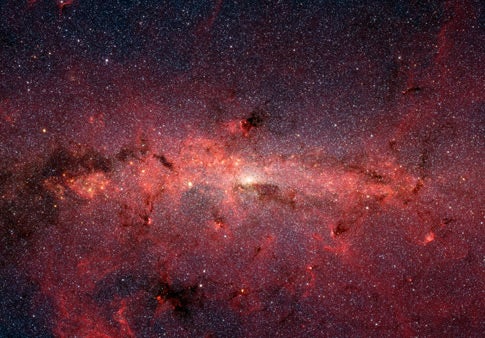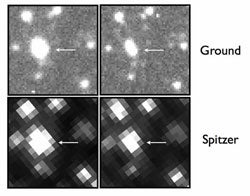An international team of astronomers led by Ohio State University has examined dark matter in the outer reaches of our galaxy in a new way.
For the first time, they were able to employ triangulation — a method rooted in ancient Greek geometry — to estimate the location of dark matter and calculate its mass.
The results, reported May 30 at the meeting of the American Astronomical Society in Honolulu, suggest that this technique could help astronomers detect dark matter of a particular mass range for which there were previously no reliable tests.
It could also settle longstanding questions about the composition of dark matter in the outer reaches of the Milky Way — the so-called galactic “halo.”
Dark matter is, by its nature, invisible. But astronomers can watch the sky for those rare moments when dark matter affects visible objects. One such opportunity is a gravitational lensing event — when one dark object in space acts like a lens to magnify the light from a star shining behind it.
“Astronomers have discovered more than a dozen lensing events that could have been caused by dark matter objects lying in the halo,” said team leader Andrew Gould, professor of astronomy at Ohio State. “But because we had no way to estimate their distance, we couldn’t tell whether they were really dark objects in our halo, or just garden-variety stars in another galaxy.”
This study marks the first time that anyone has triangulated a lensing event by observing it from the ground and from space at the same time.
On Earth, surveyors triangulate an object by observing it from two different vantage points. The two vantage points and the object itself form the vertices of a triangle. Knowing the distance between the vantage points and the angles of the triangle, surveyors can calculate how far away the object is.
To study dark matter, Gould and his team used triangulation a little differently. Over the summer of 2005, they watched a lensing event from two locations: Earth, and NASA’s Spitzer Space Telescope, which is orbiting the sun some 25 million miles away. Earth, the Spitzer telescope, and the dark matter formed a giant cosmic triangle.
The astronomers didn’t measure the angles of the triangle to calculate the distance to the object as a surveyor would on Earth. That’s because lensing events are all about timing. The dark matter lens is moving, and so astronomers learn about the lens by watching how quickly the light brightens and fades over a brief few days as the lens passes by. Seen from Earth and from the Spitzer telescope, the peak brightness would occur at slightly different times.
So when Gould and his team triangulated OGLE-2005-SMC-001, they didn’t directly measure its distance, but rather the velocity with which it was moving across the sky.
Since astronomers know roughly how fast an object in our galactic halo should be moving, compared to an object in another galaxy — in this case, the Small Magellanic Cloud (SMC) — they could infer from the velocity whether the lens was a halo object or an SMC object.
They calculated a 95 percent likelihood that the lens was in the halo. That would place the dark matter some 16,000 light years away from Earth. A light year is the distance light travels in a year — approximately six trillion miles.
Then, by factoring in other information about the timing of the brightness, they were able to determine that the lens in this case was made of two separate dark objects: one roughly seven times more massive than our sun, and the other three times more massive than our sun. The objects circle each other, separated by a distance roughly the same as that between Jupiter and the sun.
All this calculation adds up to one tantalizing possibility: that the dark matter lenses are black holes.
“If this lens is in the halo, it is a 10 solar-mass black-hole binary, which would be very exciting,” said Ohio State doctoral student Subo Dong, lead author of the study. “But we cannot completely rule out the possibility of the lens being in the SMC. In fact, there is still a 5 percent chance that it is a pair of ordinary stars in the neighboring galaxy.”
At its outermost edges, the Milky Way retains a halo of material left over from when the galaxy first formed billions of years ago. The halo contains gas and very old stars, but its chief ingredient is dark matter. Most astronomers agree that a small minority of halo dark matter — no more than 20 percent — could be made of planets, dim stars, or black holes. These are called Massive Compact Halo Objects, or MACHOs.
But there’s a gap in astronomers’ knowledge when it comes to detecting MACHOs of a particular mass range — 10-100 solar masses. For those objects, there have been no reliable methods — until now.
With a combined mass of about 10 solar masses, the two dark objects that Gould’s team detected fall within that range. So the method they used could finally enable astronomers to take a survey of 10-100 solar mass dark objects in the halo.
Dong sees a lot of potential for future discoveries with this observational method.
“It will be very interesting to locate and measure the mass of more dark objects in the future by applying this technique,” he said. “And we might finally be able to unravel the mystery of MACHOs.”
When astronomer Sjur Refsdal of the Hamburg Observatory in Germany proposed using triangulation to study dark matter in 1966, no one could attempt it, because his technique involved combining at least two separate and distant views of an object. Since the launch of the Spitzer telescope in 2003, researchers have had an opportunity to get the right kind of space-based measurement.
Gould is confident that over the next few years, he and his colleagues will be able to capture a few more lens events with the Spitzer telescope, and will gain a better perspective on the variety of dark objects that may populate the halo. But he also looks forward to a new satellite instrument, NASA’s SIM PlanetQuest (formerly the Space Interferometry Mission), now set to launch in 2015, which could provide more answers. Gould is on the SIM science team, and leads the project that will use the satellite to search for lensing events.
“Right now we know with a high probability that these objects we found are in the halo, but with SIM we could just directly measure the distance, as well as the mass of the objects,” he said. “We wouldn’t be dealing with probabilities anymore.”











